Dahlias
BackDahlias provide an amazing burst of colour during summer and autumn with their elegant blooms in all colours except blue. Dahlias are part of the daisy family and are really very easy to grow. Everyone should find space in their garden for some of these beauties!
Types of Dahlias
With over 40 species and thousands of hybrids and cultivars you’re spoilt for choice when it comes to dahlias. Within all that choice there are some distinct groups mostly based on flower shape/size. These include:
Pompom dahlias – as the name suggests these dahlias have very compact flower heads which resemble pompoms. Flowers are fully double with a rounded tip on each petal and plants grow between 60-120cm high.
Cactus or Spider dahlias – the petals with these dahlias turn under along their side edges making them look narrow and spiky. They come in a huge range of colours and grow up to 150cm high. Flowering takes about 8 weeks from planting.
Anemone or Collarette dahlias – these dahlias have an outer layer of flat petals with a central ring of shorter, ruffled petals. They usually don’t need staking as they only grow 30-60cm high.
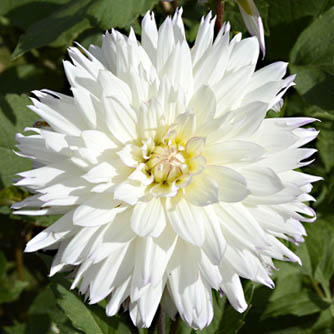
An unmissable white dahlia
Dinner-plate dahlias – Aptly named because the flowers can be an incredible 30cm wide! These are the giants of the dahlias and arguably the most spectacular. Tall growing plants and with such big flowers they definitely require staking.
Dwarf or Bambino dahlias – at the opposite end are dwarf cuties which grow to just 50cm. They are small and bushy and best of all don’t require any staking. Flowers are usually single or semi layered.
Dark Foliage dahlias – there are a few dahlias which contrast bright flowers with stunning dark foliage. The most famous is ‘Bishop of Llandaff’ popular for its intense red flowers and dark purple foliage. Most grow to a medium height.
Tree dahlias – this species dahlia (D. imperialis) grows to soaring heights of 3-5m each year before dying down in late autumn. Definitely needs staking or a very sheltered position. Pink and white flowering forms are available.
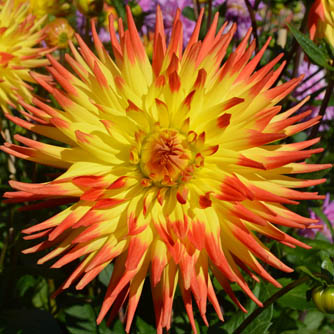
Two toned cacti dahlia
How To Grow Dahlias
Dahlias are most commonly grown from tubers purchased via mail order companies or direct from nurseries. If purchasing from a store check that tubers are plump and firm and not shrivelled, mouldy or sprouting. Later in summer you may also see potted plants for sale in nurseries.
Dahlias can also be grown from seed with most seeds available usually being dwarf varieties. If planted in spring they will grow fast enough to flower for you in summer. Sow seed in punnets first and then plant out when seedlings are large enough (approx 5cm).
Note that dahlias are frost sensitive so you need to time your planting (either tubers or seedlings) to avoid their delicate growth being burnt by late frosts. October and November are popular planting times in most areas.
Plant dahlias in a full sun position that has protection from strong winds. They will do best in free-draining fertile soil so before planting work in some compost, manure and pelleted certified organic fertiliser.
Tubers should be planted with their growing points facing upwards but don’t get too stressed if you’re unsure as the tubers will work things out. If planting a tall growing type you should stake now. Staking at a later date runs the risk of damaging the tuber and roots.
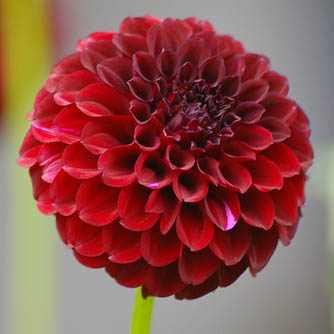
Pompom dahlia
Both tubers and seedlings should be watered in with OCP eco-seaweed to encourage roots to start growing quickly. For the tubers keep the soil moist but not wet until the new shoots appear.
Dahlias can also be grown successfully in pots using a quality potting mix. Dwarf varieties perform extremely well in pots but taller growing plants will need extra care to ensure enough water and nutrients are supplied through the growing period.
Fertilising and Maintenance of Dahlias
Dahlias are thirsty, hungry plants. In addition to improving the soil at planting time we recommend applying a mix of OCP eco-seaweed and OCP eco-aminogro every 2-3 weeks. This will super charge the plants and promote better flowering. Remember to also be generous with your watering during the heat of summer.
As the dahlias grow, tie them to the stake for support and pinch out new shoots a couple of times to bush up the plants and create more flowers. Removing old flowers will also encourage more blooms.
Remember dahlias make great long lasting cut flowers and the more you pick them, the more the plant will produce!
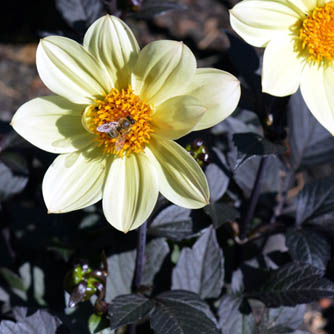
Simple anemone dahlia but with dark foliage
Lifting and Dividing Dahlia Tubers
In late autumn plants will begin to fade with fewer blooms and pretty sad looking foliage. In colder climates they will die down completely while in milder climates they’ll hang on for longer. Either way when the plants are ‘done’ you’ll need to cut the stems down to the ground. In regions with frosts the tubers are lifted, brushed free of soil and stored in a dark cool place over winter. Do not allow tubers to actually dry out and become shrivelled. Also protect them from hungry vermin which will happy munch away.
In frost free regions tubers can remain in the ground as long as there is good drainage. Tubers will rot if the soil stays wet during their dormant period.
Large tuber clumps can divided in spring before replanting. When dividing it is important to make sure that each division has a piece of the old stem attached to it as this is where the growing buds are located. And remember that the larger the pieces the better the blooming so don’t over divide.
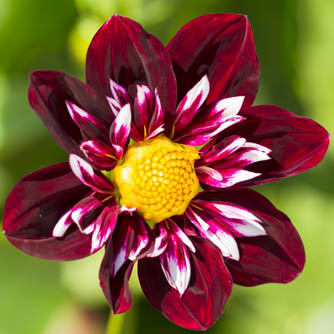
Fancy collarette dahlia
Pest and Diseases of Dahlias
Unfortunately there are a few things which enjoy dahlias as much as we do! Here are the common problems to look out for:
- Sap sucking insects including aphids, whiteflies, mealybugs or mites – spray thoroughly with OCP eco-oil or OCP eco-neem at the first sign of problems.
- Chewing insects like caterpillars and grasshoppers can attack flowers and leaves. Use OCP eco-neem to fix these problems.
- Slugs and snails like to chew holes in the new shoots as they emerge from the soil. Dwarf dahlias are vulnerable to foliage being eaten at any time. Apply OCP eco-shield pellets to protect plants as required.
- Powdery mildew – dahlias are very susceptible to this common disease. Apply an organic fungicide when first spotted and to help reduce repeat infections increase air circulation around the plant and avoid wetting leaves when watering.
- Other fungal problems – there are various leaf spots and stem rots which sometimes occur if plants are not growing in ideal conditions. Ensure tubers are in soil which drains well as a preventative step and then maintain strong healthy growth using OCP eco-seaweed and OCP eco-aminogro on a regular basis as a foliar spray. This will ‘toughen up’ the plants to help develop better resilience to diseases.
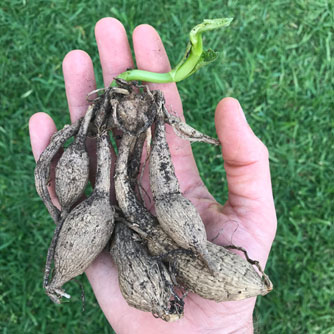
Dahlia tuber with young shoot


